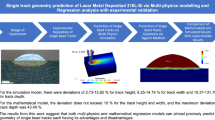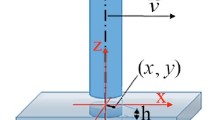Abstract
The direct laser metal deposition (DLMD) is an emerging technology in the additive manufacturing field, which is becoming widely adopted in several industrial applications. The optimal selection of process parameters is critical, given the cost of physical tests and the requirement for high-quality manufacturing. Correct forecasting of process parameters using predictive physical models is a viable alternative to shorten the setup phase and improve the sustainability. In this paper, firstly, several models available so far in the literature are reviewed, and then, a general model is derived to evaluate the best combination of process parameters in single track operations. The proposed phenomenological model allows simple forecasting based on three main process parameters: laser power (P), powder feed rate (F) and translation speed (V). An innovative approach is proposed to generalise the model and overcome the “try and error” method used in numerous works to determine the exponents (α, β, γ). The model was designed considering the physical parameters which best explained the variability of the exponents: the thermal diffusivity of the base material and the density of the powder material. The best ranges of the process parameter exponents are suggested to establish the most suitable combined parameters for the prediction of geometric characteristics of the clad. The potentialities of the model are proven based on an experimental case performed over a commercially available Nickel-based super-alloy powder. New formulations are recommended, which are in good agreement with the behaviours defined in the literature, as shown in the test case.










Similar content being viewed by others
Abbreviations
- P:
-
Laser power
- V:
-
Translation speed
- F:
-
Powder feed rate
- W:
-
Clad width
- H:
-
Clad height
- p:
-
Clad penetration depth
- A c :
-
Clad area
- A m :
-
Substrate molten area
- Dil:
-
Dilution
- Dt:
-
Thermal diffusivity
- α:
-
Absorbance of powder
- η d :
-
Laser power dependent deposition efficiency
- η i :
-
Laser power independent deposition efficiency
- η melt :
-
Substrate melting efficiency
- ρ (p) :
-
Powder density
- ρ (s) :
-
Substrate density
- C (p) :
-
Specific heat of powder
- T (p) :
-
Melting temperature of powder
- L f(p) :
-
Latent heat of fusion of powder
- C (s) :
-
Specific heat of substrate
- T (s) :
-
Melting temperature of substrate
- L f(s) :
-
Latent heat of fusion of substrate
References
Tay S, Te Chuan L, Aziati A, Ahmad ANA (2018) An overview of industry 4.0: definition, components, and government initiatives. J Adv Res Dyn Control Syst 10:14
Dilberoglu UM, Gharehpapagh B, Yaman U, Dolen M (2017) The role of additive manufacturing in the era of Industry 4.0. Proc Manuf 11:545–554. https://doi.org/10.1016/j.promfg.2017.07.148
Horst D, Duvoisin C, Vieira R (2018) Additive manufacturing at Industry 4.0: a review. Int J Eng Tech Res 8:3–8
Despeisse M, Ford S (2015) The role of additive manufacturing in improving resource efficiency and sustainability. In: Umeda S, Nakano M, Mizuyama H et al (eds) Advances in production management systems: innovative production management towards sustainable growth. Springer International Publishing, Cham, pp 129–136
Siva Prasad H, Brueckner F, Volpp J, Kaplan AFH (2020) Laser metal deposition of copper on diverse metals using green laser sources. Int J Adv Manuf Technol 107:1559–1568. https://doi.org/10.1007/s00170-020-05117-z
Errico V, Campanelli SL, Angelastro A, Mazzarisi M, Casalino G (2020) On the feasibility of AISI 304 stainless steel laser welding with metal powder. J Manuf Process 56:96–105. https://doi.org/10.1016/j.jmapro.2020.04.065
Srivastava D, Chang ITH, Loretto MH (2000) The optimisation of processing parameters and characterisation of microstructure of direct laser fabricated TiAl alloy components. Mater Des 21:425–433. https://doi.org/10.1016/S0261-3069(99)00091-6
Yang LX, Peng XF, Wang BX (2001) Numerical modeling and experimental investigation on the characteristics of molten pool during laser processing. Int J Heat Mass Transf 44:4465–4473. https://doi.org/10.1016/S0017-9310(01)00086-2
Guan X, Zhao YF (2020) Modeling of the laser powder–based directed energy deposition process for additive manufacturing: a review. Int J Adv Manuf Technol 107:1959–1982. https://doi.org/10.1007/s00170-020-05027-0
Zhang Z, Ge P, Yao XX, Li T, Liu WW (2020) Numerical studies of residual states and scaling effects in laser-directed energy deposition additive manufacturing. Int J Adv Manuf Technol 108:1233–1247. https://doi.org/10.1007/s00170-020-05300-2
Han L, Phatak KM, Liou FW (2004) Modeling of laser cladding with powder injection. Metall Mater Trans B Process Metall Mater Process Sci 35:1139–1150. https://doi.org/10.1007/s11663-004-0070-0
Kumar A, Roy S (2009) Development of a theoretical process map for laser cladding using a three-dimensional conduction heat transfer model. Numer Heat Transf Part Appl 56:478–496. https://doi.org/10.1080/10407780903266489
Wen S, Shin YC (2010) Modeling of transport phenomena during the coaxial laser direct deposition process. J Appl Phys 108:044908. https://doi.org/10.1063/1.3474655
Pinkerton AJ, Li L (2004) Modelling the geometry of a moving laser melt pool and deposition track via energy and mass balances. J Phys Appl Phys 37:1885–1895. https://doi.org/10.1088/0022-3727/37/14/003
Xi W, Song B, Zhao Y, Yu T, Wang J (2019) Geometry and dilution rate analysis and prediction of laser cladding. Int J Adv Manuf Technol 103:4695–4702. https://doi.org/10.1007/s00170-019-03932-7
Zhu S, Chen W, Ding L, Zhan X, Chen Q (2019) A mathematical model of laser cladding repair. Int J Adv Manuf Technol 103:3265–3278. https://doi.org/10.1007/s00170-019-03588-3
Reddy L, Preston SP, Shipway PH, Davis C, Hussain T (2018) Process parameter optimisation of laser clad iron based alloy: predictive models of deposition efficiency, porosity and dilution. Surf Coat Technol 349:198–207. https://doi.org/10.1016/j.surfcoat.2018.05.054
Alekseev AV, Turichin GA, Klimova-Korsmik OG, Valdaytseva EA, Rashkovets MV, Nikulina AA (2020) Simulation of the Ni3Al intermetallic inclusion growth process during direct laser deposition using Ni-based superalloy powder. Mater Today Proc 30:756–760. https://doi.org/10.1016/j.matpr.2020.01.562
Costa L, Felde I, Réti T, Kálazi Z, Colaço R, Vilar R, Verő B (2003) A simplified semi-empirical method to select the processing parameters for laser clad coatings. Mater Sci Forum 414–415:385–394. https://doi.org/10.4028/www.scientific.net/MSF.414-415.385
de Oliveira U, Ocelík V, De Hosson JTM (2005) Analysis of coaxial laser cladding processing conditions. Surf Coat Technol 197:127–136. https://doi.org/10.1016/j.surfcoat.2004.06.029
Ocelík V, de Oliveira U, de Boer M, de Hosson JTM (2007) Thick Co-based coating on cast iron by side laser cladding: analysis of processing conditions and coating properties. Surf Coat Technol 201:5875–5883. https://doi.org/10.1016/j.surfcoat.2006.10.044
El Cheikh H, Courant B, Hascoët J-Y, Guillén R (2012) Prediction and analytical description of the single laser track geometry in direct laser fabrication from process parameters and energy balance reasoning. J Mater Process Technol 212:1832–1839. https://doi.org/10.1016/j.jmatprotec.2012.03.016
Nenadl O, Kuipers W, Koelewijn N, Ocelík V, de Hosson JTM (2016) A versatile model for the prediction of complex geometry in 3D direct laser deposition. Surf Coat Technol 307:292–300. https://doi.org/10.1016/j.surfcoat.2016.08.090
Barekat M, Shoja Razavi R, Ghasemi A (2016) Nd:YAG laser cladding of Co–Cr–Mo alloy on γ-TiAl substrate. Opt Laser Technol 80:145–152. https://doi.org/10.1016/j.optlastec.2016.01.003
Ansari M, Shoja Razavi R, Barekat M (2016) An empirical-statistical model for coaxial laser cladding of NiCrAlY powder on Inconel 738 superalloy. Opt Laser Technol 86:136–144. https://doi.org/10.1016/j.optlastec.2016.06.014
Erfanmanesh M, Abdollah-Pour H, Mohammadian-Semnani H, Shoja-Razavi R (2017) An empirical-statistical model for laser cladding of WC-12Co powder on AISI 321 stainless steel. Opt Laser Technol 97:180–186. https://doi.org/10.1016/j.optlastec.2017.06.026
Nabhani M, Razavi RS, Barekat M (2018) An empirical-statistical model for laser cladding of Ti-6Al-4V powder on Ti-6Al-4V substrate. Opt Laser Technol 100:265–271. https://doi.org/10.1016/j.optlastec.2017.10.015
Bax B, Rajput R, Kellet R, Reisacher M (2018) Systematic evaluation of process parameter maps for laser cladding and directed energy deposition. Addit Manuf 21:487–494. https://doi.org/10.1016/j.addma.2018.04.002
El Cheikh H, Courant B, Branchu S et al (2012) Analysis and prediction of single laser tracks geometrical characteristics in coaxial laser cladding process. Opt Lasers Eng 50:413–422. https://doi.org/10.1016/j.optlaseng.2011.10.014
Riquelme A, Escalera-Rodriguez MD, Rodrigo P, Rams J (2016) Role of laser cladding parameters in composite coating (Al-SiC) on aluminum alloy. J Therm Spray Technol 25:1177–1191. https://doi.org/10.1007/s11666-016-0431-7
Caiazzo F, Alfieri V, Argenio P, Sergi V (2017) Additive manufacturing by means of laser-aided directed metal deposition of 2024 aluminium powder: investigation and optimization. Adv Mech Eng 9:168781401771498. https://doi.org/10.1177/1687814017714982
Chen Y, Wang X, Zhao Y, Song B, Yu T (2020) Interactive optimization of process parameters and coating analysis of laser cladding JG-3 powder. Int J Adv Manuf Technol 107:2623–2633. https://doi.org/10.1007/s00170-020-05155-7
Peng L, Taiping Y, Sheng L, Dongsheng L, Qianwu H, Weihao X, Xiaoyan Z (2005) Direct laser fabrication of nickel alloy samples. Int J Mach Tools Manuf 45:1288–1294. https://doi.org/10.1016/j.ijmachtools.2005.01.014
Aggarwal K, Urbanic RJ, Saqib SM (2018) Development of predictive models for effective process parameter selection for single and overlapping laser clad bead geometry. Rapid Prototyp J 24:214–228. https://doi.org/10.1108/RPJ-04-2016-0059
Saqib S, Urbanic RJ, Aggarwal K (2014) Analysis of laser cladding bead morphology for developing additive manufacturing travel paths. Proc CIRP 17:824–829. https://doi.org/10.1016/j.procir.2014.01.098
Yu T, Yang L, Zhao Y, Sun J, Li B (2018) Experimental research and multi-response multi-parameter optimization of laser cladding Fe313. Opt Laser Technol 108:321–332. https://doi.org/10.1016/j.optlastec.2018.06.030
Sun Y, Hao M (2012) Statistical analysis and optimization of process parameters in Ti6Al4V laser cladding using Nd:YAG laser. Opt Lasers Eng 50:985–995. https://doi.org/10.1016/j.optlaseng.2012.01.018
Shi Y, Li Y, Liu J, Yuan Z (2018) Investigation on the parameter optimization and performance of laser cladding a gradient composite coating by a mixed powder of Co50 and Ni/WC on 20CrMnTi low carbon alloy steel. Opt Laser Technol 99:256–270. https://doi.org/10.1016/j.optlastec.2017.09.010
Verdi D, Múnez CJ, Garrido MA, Poza P (2017) Process parameter selection for Inconel 625-Cr3C2 laser cladded coatings. Int J Adv Manuf Technol 92:3033–3042. https://doi.org/10.1007/s00170-017-0372-4
Caiazzo F (2018) Laser-aided directed metal deposition of Ni-based superalloy powder. Opt Laser Technol 103:193–198. https://doi.org/10.1016/j.optlastec.2018.01.042
Funding
This research received no specific grant from any funding agency in the public, commercial, or not-for-profit sectors.
Author information
Authors and Affiliations
Corresponding author
Ethics declarations
Conflict of interest
The authors declare that they have no conflict of interest.
Additional information
Publisher’s note
Springer Nature remains neutral with regard to jurisdictional claims in published maps and institutional affiliations.
Rights and permissions
About this article
Cite this article
Mazzarisi, M., Campanelli, S.L., Angelastro, A. et al. Phenomenological modelling of direct laser metal deposition for single tracks. Int J Adv Manuf Technol 111, 1955–1970 (2020). https://doi.org/10.1007/s00170-020-06204-x
Received:
Accepted:
Published:
Issue Date:
DOI: https://doi.org/10.1007/s00170-020-06204-x




